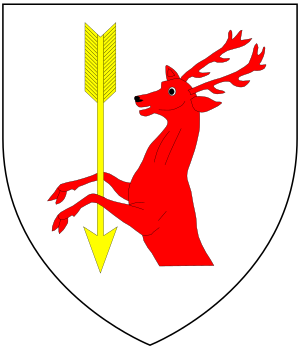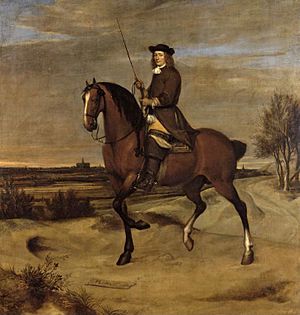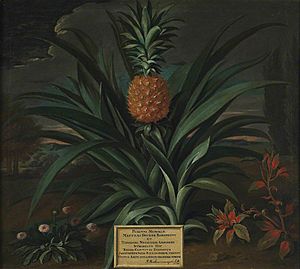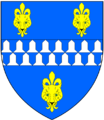Matthew Decker facts for kids

Sir Matthew Decker, 1st Baronet (1679 – 18 March 1749) was a very successful merchant and economist. He was born in Holland but moved to England and became a British citizen. He lived in Richmond Green in Surrey.
Sir Matthew was a Member of Parliament (MP) for Bishop's Castle from 1719 to 1722. He was also a leader in important trading companies. He was a governor of the South Sea Company and a director of the East India Company for many years.
He strongly believed in "free trade." This means he thought countries should trade with each other without many taxes or rules. He suggested getting rid of customs duties (taxes on imported goods) and replacing them with other taxes. He also wanted to remove taxes on tea and other imports.
At his home in Richmond, he collected a huge amount of art, especially Dutch paintings. This collection later became the main part of the Fitzwilliam Museum, which was started by his grandson. Sir Matthew was also one of the first people in England to grow exotic fruits like pineapples and lemons in heated greenhouses.
Contents
Where Sir Matthew Decker Came From
Sir Matthew Decker was born in 1679 in Amsterdam, Holland. His father was Dirck Decker, and his mother was Katherina. Dirck was born around 1642 in Bloemendaal, near Haarlem. His grandfather, Cornelius Decker, was a linen bleacher (someone who whitens linen fabric) in Bloemendaal.
A portrait of Dirck Decker shows him on horseback in sand dunes with the Grote Kerk, Haarlem church in the background. This might show the area where Cornelius Decker's bleaching grounds were located.
According to a herald (an expert in family crests and history) named Sir John Vanburgh, Sir Matthew's ancestors were from Flanders (an area in modern-day Belgium). They moved to Holland to escape religious persecution during a difficult time when the Duke of Alva was in charge of the Spanish Netherlands.
Sir Matthew Decker's Career
Sir Matthew studied business in Amsterdam. By 1702, when he was 23, he moved to the City of London. There, he started his own business as a merchant, focusing on linen. He was incredibly successful and became very wealthy and respected.
By 1710, he was a major player in trade between England and Holland. He worked with several Dutch banks. From 1711 to 1712, he was one of the first directors of the South Sea Company. However, he soon became more interested in the East India Company. He was a director there from 1713 to 1743. On July 20, 1716, King George I gave him the special title of "baronet."
In 1719, he helped create the Royal Academy of Music. This company started an opera house in London that hired famous composers like Handel and Bononcini.
Sir Matthew also worked for James Brydges, who later became the 1st Duke of Chandos. Brydges helped him become a Member of Parliament for Bishop's Castle in 1719. Sir Matthew bought paintings and tapestries for Brydges in the Netherlands. He was also a leader in the Royal African Company and the East India Company. By 1721, he decided he had enough of Parliament and did not run for re-election.
After the "South Sea Bubble" financial crisis, Sir Matthew gave an important speech in 1720. He supported a plan to help the economy recover. He said he would give up almost all his wealth to help the country.
He served as the Governor of the East India Company from 1725 to 1726 and again from 1730 to 1733. He was also chosen to be the Sheriff of Surrey in 1729.
Sir Matthew Decker's Home in Richmond
Sir Matthew's large house and estate were located in Richmond Green, near the old Richmond Palace. The house was first built by Sir Charles Hedges and then bought by Sir Matthew. Later, his grandson, Richard FitzWilliam, 7th Viscount FitzWilliam, inherited it. He called it "FitzWilliam House" and kept his famous art collection there. This collection later became the basis for the Fitzwilliam Museum in Cambridge. The house was torn down in 1840.
John Macky described Sir Matthew's estate in Richmond in the 1720s. He mentioned a very long and tall holly hedge, other evergreen hedges, paths through woods, and fountains. There was also a beautiful canal leading from the river. Macky noted a special "Duckery" (a pond for ducks) and a lovely summer house. He also highlighted the "Stove-Houses," which were heated greenhouses kept at a steady temperature for growing citrus fruits and other exotic plants. Sir Matthew even hired gardeners from other countries to manage them.
Growing Pineapples in England
Sir Matthew Decker was famous for being one of the first people to successfully grow pineapples in England. A painting from 1720 by Theodorus Netscher shows one of his prize English-grown pineapples. The painting has a Latin message that says: "To the perpetual memory of Matthew Decker, Baronet, and Theodore Netscher, Gentleman. This pineapple, deemed worthy of the royal table, grew at Richmond at the cost of the former, and still seems to grow by the art of the latter. H(enry) Watkins (Decker's brother-in-law) set up this inscription, A.D. 1720." This suggests that Sir Matthew may have even served a pineapple to King George I!
Richard Bradley, a writer on gardening, described Sir Matthew's pineapple growing in 1723. He saw about 40 fruiting pineapples at Sir Matthew's estate in Richmond. Some were ripening, and others looked promising. The smallest fruit was over four inches long, and some were as large as those from the West Indies. He measured one that was almost seven inches long and nearly thirteen inches around! Bradley praised Sir Matthew's gardener, Mr. Henry Telende, for making pineapple growing seem easy. He hoped that many more English gardens would soon grow pineapples.
Today, pineapples are a symbol at the Fitzwilliam Museum. The museum's railings have gilded pineapples, and they even commissioned a giant "Architectonic Pineapple" for their front lawn. The museum has also held conferences dedicated to the history of pineapples.
Sir Matthew Decker's Family
Before 1711, Sir Matthew married Henrietta Watkins. She was one of 16 children of Rev. Richard Watkins. Henrietta's brother, Henry Watkins, was a diplomat and army administrator. He spent a lot of time in Holland, and it was through him that Sir Matthew met Henrietta.
Sir Matthew and Henrietta had one son, who died young, and three daughters:
- Catherine Decker (died 1786): She married Richard FitzWilliam, 6th Viscount FitzWilliam. They had at least seven children, including Richard FitzWilliam, 7th Viscount FitzWilliam (1745-1816). This grandson inherited Sir Matthew's house and art collection in Richmond. He later founded the Fitzwilliam Museum in Cambridge through his will.
- Henrietta Anne Decker (died 1747): She married John Talbot, a judge and MP, but they had no children.
- Mary Decker: She married William Croftes and was the mother of Richard Croftes (1740-1783), who also became an MP.
Death and Legacy
Sir Matthew Decker passed away on March 18, 1749. Since his only son had died young, he had no male heir to inherit his special title, so the baronetcy ended. He was buried at St Mary Magdalene, Richmond, where a monument stands in his memory. The monument was sculpted by Peter Scheemakers in 1759.
A modern inscription on the monument states: "In the vault beneath were interred the remains of Sir Matthew Decker Bart. on the 25th of March 1749 and of his relict Lady Decker on the 12th of May 1759. Also of Catherine their daughter and wife of Richard 6th Viscount FitzWilliam of Mount Merrion in the County of Dublin in the Kingdom of Ireland. She died on the 8th of March 1786. The remains of Richard Viscount FitzWilliam son of the above-named Richard and Catherine were also interred here. He died on the 4th of February 1816 in the 71st year of his age and by his will founded and endowed the museum at Cambridge that bears his name."
Sir Matthew's wealth and estates went to his surviving daughter, Catherine, and then to her son, Richard FitzWilliam, 7th Viscount FitzWilliam. This is how Sir Matthew's amazing art collection eventually led to the creation of the famous Fitzwilliam Museum.
Images for kids









